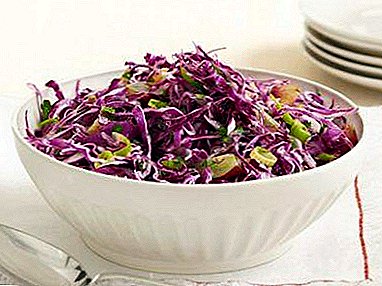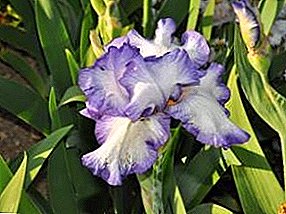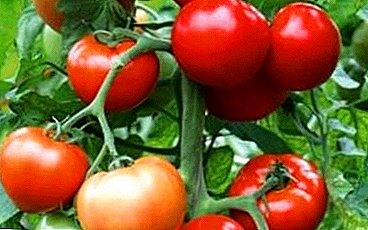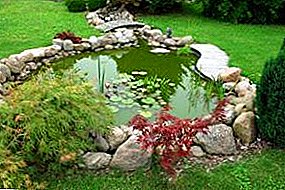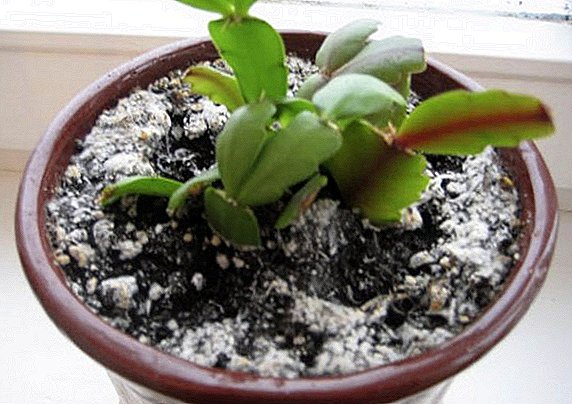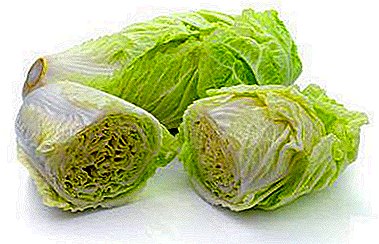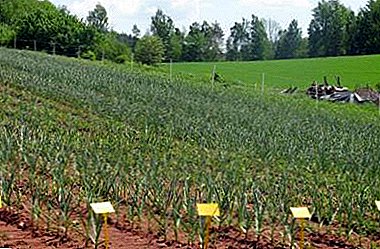
Own business is the main way of obtaining financial independence. Often, start-up entrepreneurs do not have enough start-up capital. Therefore, the main condition for starting a business is the availability of finances to start a business.
Growing garlic as an activity at low cost is exactly the start of an enterprise that does not require significant financial investment and is highly profitable. To obtain high performance and large profits, you need to study the agrotechnology of cultivation and understand the details of this production.
Advantages and disadvantages
disadvantages:
- at the initial stage it is difficult to find a reliable supplier of seed;
- the need for soil cultivation and fertilization;
- the growth of winter varieties of garlic will require soil with a sand content;
- in the absence of wholesale buyers, there may be difficulties with sales.
Benefits:
- high popularity of the product among the population;
- slight competition;
- simple agrotechnology;
- the possibility of growing in a small area;
- availability of agricultural machinery is not necessary;
- small amount of initial investment;
- To start this type of activity, no special knowledge is needed.
Reference! When growing garlic, it is also advisable to grow vegetables and onions.
The average yield of 1 ha and 1 acres in Russia
How many kg of the product can be grown for 1 hectare and how much can be collected from 1 hectare for sale? If the main agricultural technologies are observed, a garlic harvest of about 13 tons can be obtained from 1 hectare of land, therefore, from 1 hectare the yield will be 130 kilograms.
Material costs
 To prepare the soil area of 20 acres, you need to spend 6000 rubles. According to the plan, this includes plowing, harrowing, as well as preparing the soil directly for planting. The price of planting material will be approximately 20,000, since it will take at least 200 kg for sowing on an area of 20 acres (at a price of 100 rubles per kilogram of seed material).
To prepare the soil area of 20 acres, you need to spend 6000 rubles. According to the plan, this includes plowing, harrowing, as well as preparing the soil directly for planting. The price of planting material will be approximately 20,000, since it will take at least 200 kg for sowing on an area of 20 acres (at a price of 100 rubles per kilogram of seed material).
To prepare the soil will require 8 tons of fertilizer - peat or humus. For this you will need to pay 25,000 rubles.
Storage of the grown product is possible.:
- in the already existing country house.
- construction of specialized storage for garlic.
The total cost of creating a business according to the developed plan is about 90,000 rubles. But in the presence of a ready-made structure adapted for storing garlic, the construction of a warehouse is no longer necessary. If there are good soil conditions that are suitable for growing onion crops, it is possible to reduce the amount of fertilizer applied. These factors can significantly reduce the amount of starting production costs.
Profitability
Considering that the average yield per hectare is 13 tons of finished products, how much garlic can be obtained from 20 acres? In this case, from 20 acres, you can expect about 2.5 tons of garlic, for an approximate amount of 25,000 rubles, with an average market price of 50 rubles per kilogram.
Is it profitable to grow for sale on a large scale?
What benefits can be obtained from industrial cultivation in the open field? This business can reasonably be called promising and having high rates of return. This is due to the high demand for the product from the population. If you want to start a garlic business, then there is every reason to start a business safely..
Cultivation technology on an industrial scale
Asking how to grow garlic on an industrial scale, an aspiring farmer must draw up a detailed business plan in order to successfully bring the business idea to life.
Market analysis
Garlic is in high demand among people. When grown both on an industrial scale and in a small agricultural enterprise, trading in two forms is possible:
- Retail. It is advisable to rent a small shopping module, for example, in the local market.
- About. This will require the establishment of contacts with wholesale buyers.
The choice of the form of sales of products primarily depends on its volume.
The payback of this business is 1 season!
Total investment
 In addition to the above amounts of money (planting material, soil preparation and fertilizer), it is necessary to take into account other costs associated with ensuring the activities of agricultural enterprises:
In addition to the above amounts of money (planting material, soil preparation and fertilizer), it is necessary to take into account other costs associated with ensuring the activities of agricultural enterprises:
- rent for the use of land;
- fare;
- salary to the hired personnel in case of its attraction;
- the cost of the purchase and use of pesticides;
- fee for advertising services.
In each region of Russia, the prices for listed services are different and can vary greatly.
Choice of taxation system
When creating an agricultural organization, first of all you need to register it. in accordance with the established procedure, in order to avoid violation of the current norms of the current legislation. Your business must be registered without fail, especially when grown in industrial quantities.
When growing products in large industrial volumes, the best form of organization of activities will be LLC. A limited liability company is an economic company established by one or several legal entities and / or individuals, whose authorized capital is divided into shares. Members of the company are not liable for its obligations and bear the risk of losses associated with the activities of the company, within the value of their shares or shares in the authorized capital of the company.
For start-up entrepreneurs The most convenient form of organization of production will be a peasant farm (KFH) - up to 1 ha of land or as an individual entrepreneur (PI).
Types of taxation:
- peasant farm - subject to a single agricultural tax (UAT);
- individual entrepreneur - simplified taxation system (USN).
The tax rate is the same for both forms of registration. When registering, apply OKVED classifier code 01.13 "cultivation of root crops, onion vegetables and tubers, such as: carrots, table beets, turnips, garlic, onions (including shallots), leeks and other onion vegetables." Registration term is 1 month.
Algorithm of actions for registration of IP:
- Collection of documents (application for state registration of an individual as an individual entrepreneur (Form No. P21001); copy of a passport; receipt of payment of state duty).
- The state registration of an individual as an individual entrepreneur takes place in the tax authority at his place of residence, that is, at the place of registration indicated in the passport. If there is no place of registration in the passport, then the registration of the entrepreneur can be carried out in the tax authority at the place of actual residence.
 Transfer of documents to the tax office. They can be transferred in person or remotely directly to the inspection.
Transfer of documents to the tax office. They can be transferred in person or remotely directly to the inspection.- In person or through proxy. It is also possible to execute documents in the multifunctional center - in person or through a proxy representative.
- Reception of documents in the tax authority.
- Reception by the person of documents on the state registration.
- If all documentation is in order, after 3 workers, the EGRIP record sheet is issued to the applicant.
Documents can be obtained personally or through a representative of a notarized power of attorney.
Which grade to choose?
The main varieties of garlic are:
- spring;
- winter.
Winter garlic is well tolerated by low temperatures, has high yields, large onions and good taste. Its landing is carried out in the period from September to October. The most common and high-yielding varieties:
- Scythian;
- Saved;
- Pluto;
- Healer;
- Garkua;
- Autumn;
- Polessky;
- Ryazhsky;
- Lyubasha.
Spring varieties of garlic are suitable only for growing in the southern regions of the Russian Federation, as they are poorly tolerated by low ambient temperatures. This increases the risk of crop failure from exposure to low temperatures.
The most high-yielding varieties of spring garlic:
- Yelenovsky;
- Kledor;
- Flavor
Description of acreage
The land under the garlic culture must be drained and fertile. The important role played by the degree of illumination area. Garlic gives the highest yields when grown in greenhouse conditions, which also makes it possible to protect crops from the effects of adverse weather conditions. Adding sand to the soil has a good effect, which increases its drainage.
Required equipment
 With small amounts of acreage, the availability of agricultural machinery is not necessary. But when grown in industrial quantities, the mechanization of this process is obligatory. In this case you must have or rental equipment:
With small amounts of acreage, the availability of agricultural machinery is not necessary. But when grown in industrial quantities, the mechanization of this process is obligatory. In this case you must have or rental equipment:
- cultivator;
- tractor;
- conveyor;
- irrigation system;
- garlic harvesting machine.
Purchase of the above equipment will cost about 5,000,000 rubles. When conducting business within the suburban area, the above equipment will not be required, but still it will be necessary to purchase gardening tools worth about 20,000 rubles.
Landing
It would be most expedient to plant winter varieties of garlic. It should be disembarked 40 days before the onset of the first frost. The best time is in September -October.
Can be used for planting:
- air bulb (bulb of an arrow);
- sevok (single-bulb bulb);
- one clove of the head.
It is recommended to carry out a seed change every 3 years, which allows avoiding the degeneration of garlic varieties. It is better to use for planting sevka or one clove of garlic, because the bulb will yield a crop only after 2 years. The volume of required seed depends on the density of planting and variety, but is in the range of 600-1,500 kg / ha.
We offer you to watch a video about planting large volumes of garlic:
Care
Watering
Between mid-April and early July, garlic is poured about once a week.. In the rainy season, watering is reduced in part or even completely. With an abundance of precipitation in the rows, they create drainage grooves to prevent the accumulation of excessive moisture in the soil. Which can lead to decay of the bulbs.
In cold summer garlic must be irrigated every 9 days. Watering should be carried out in such a way that from 5 to 10 liters of water is used for each square meter of crops. During dry periods, the volume of water for irrigation is allowed to increase to 12-15 liters.
Attention! It is recommended to stop watering garlic 3 weeks before the intended harvest.
Tillage
After heavy rains, a soil crust forms on the soil surface, preventing normal access of oxygen to the root system and deterioration of bulb growth conditions. After completion of the rains, it is necessary to carry out the process of shallow loosening (3-5cm). It improves soil aeration. It is necessary to conduct loosening so as not to damage the bulbs.
Top dressing
 It is recommended that at the beginning of the growing season 2 fertilizing of garlic crops with nitrogen fertilizers with an interval of two weeks. Winter and spring garlic are fertilized in a fortnight after the appearance of friendly shoots (April-May).
It is recommended that at the beginning of the growing season 2 fertilizing of garlic crops with nitrogen fertilizers with an interval of two weeks. Winter and spring garlic are fertilized in a fortnight after the appearance of friendly shoots (April-May).
For dressing use also solution of slurry (1:10), bird droppings (1:20). Phosphorus-potassium fertilizers are applied during planting garlic. A good result is the soaking of seed in solutions of humic fertilizers before planting, this increases the germination rate by 20%.
Fertilization in the soil should be carried out only after watering or rain.
We offer you to watch a video about garlic feeding:
On the rules of care for garlic, we wrote in our material.
Harvesting
Garlic is harvested after all the leaves turn yellow. The cleaning process should take place in dry weather. After harvesting the bulbs, they need to be dried in the open air, cut the stems and roots, to sort. Crop sale is possible:
- in the network of shops;
- In institutions catering;
- On the market;
- other wholesale buyers.
Diseases
 The main diseases of garlic are:
The main diseases of garlic are:
- garlic peronospora;
- downy mildew;
- bacterial rot;
- garlic neck rot;
- black moldy garlic rot.
To combat diseases of garlic, there is a wide range of agricultural products. It is important to detect the focus of the disease at the very beginning, which will preserve the crop.
We offer you to watch a video about garlic diseases:
Possible problems and solutions
The main problem in this type of activity is lack of funding at the initial stage of activity. In the presence of sufficient financial investments, the business of growing garlic does not bring any significant problems.
Growing garlic is a profitable and payable type of activity. It can be begun both on a personal plot, and in big territories. Also, the cultivation of garlic can start without the experience of growing crops.


 Transfer of documents to the tax office. They can be transferred in person or remotely directly to the inspection.
Transfer of documents to the tax office. They can be transferred in person or remotely directly to the inspection.
